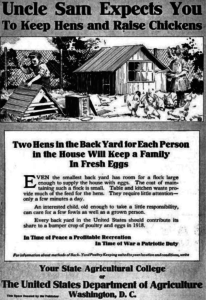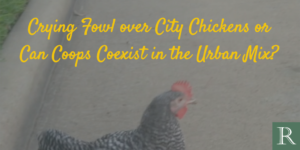Urban Chickens: How Not to Get Flocked
A city council I represent recently deadlocked on whether to allow chickens to be raised by homeowners within the city limits. This was not a rural city but one that abuts Houston’s city limits. Amazingly, raising urban chickens has developed in to a cottage (dare I say coop) industry where for the price of $300 you can have delivered to your house a chicken coop, 50 pounds of feed and two chickens (discounts apply for more than two). When the weather turns cold, simply call the chicken monger and they will come pick up your prize hen, tag and house it during the winter and return it to you ensuring a joyful spring reunion. Franchises are available! (www.rent-a-chicken.net)
It’s amazing to see the pendulum swing back from people leaving the farm and moving to the city, which restricts the raising of livestock and fowl, bringing heated arguments at council meetings and demanding their right to raise chickens on a 6,000 sq. foot lot. After all a man’s house is his castle, complete with chickens running at large. During WWI, Uncle Sam said it was your patriotic duty to raise two hens for every person living in your household.
Living Green is forcing more cities to address the raising of chickens in particular and livestock in general. Pro-chicken advocates have organized and now list the various local ordinances and state laws that affect their ability to raise chickens. One site lists 82 different city ordinances another over 700. A quick review of 22 city ordinances show that regulations fall into several categories:
- Size of lot
- Distance from neighbors
- Penned or cooped
- Total number
- Nuisance (noise, odor, pest attraction)
- Permits and building codes
- Sanitation
- Exercise area
- Total ban
- Banning roosters
- Slaughter ban
- Storage of feed
Care must be taken to balance these regulations less you offend your local 4-H club or Future Farmers of America and you end up with a council chamber full of blue corduroyed FFA members with their local AG teacher and mad parents offended by the overregulation and interference with their local school project. Spring Branch ISD, in the middle of Houston, has several AG barns for raising chickens, turkeys, rabbits, pigs, sheep, goats and cattle.
Cedar Rapids, Iowa has become the model ordinance for use by communities across the nation. That ordinance allows up to six hens; requires annual permits and notification of neighbors of intent to obtain a permit; prohibits free range chickens; regulates the square foot space per bird, coop design requirements, distance from neighbor’s houses; prohibits slaughtering; and calls for adequate food and water for the birds.
The local citizens formed a local advocacy group (Citizens for the Legalization of Urban Chickens). C.L.U.C. then contacted the head of the poultry extension service at Iowa State University, drafted an information packet, partnered with the local nature center, reached out to individual city council members, created a Facebook page and got over 1,000 likes, made a presentation that was specific and short (six hens, no roosters, no slaughtering) and got in front of city council often wearing bright yellow t-shirts printed with “Got Eggs?”. The ordinance passed.
We sometimes play a silly game of name that group noun. A group of bees is called a swarm, for owls a parliament, for crows a murder. Getting attacked by one bird is called flocking, by a group mobbing. If you look up one day at a council meeting and see only one bright yellow t-shirt, you are about to get flocked. But if you see many, you are about to get mobbed. The birds are coming, run!
